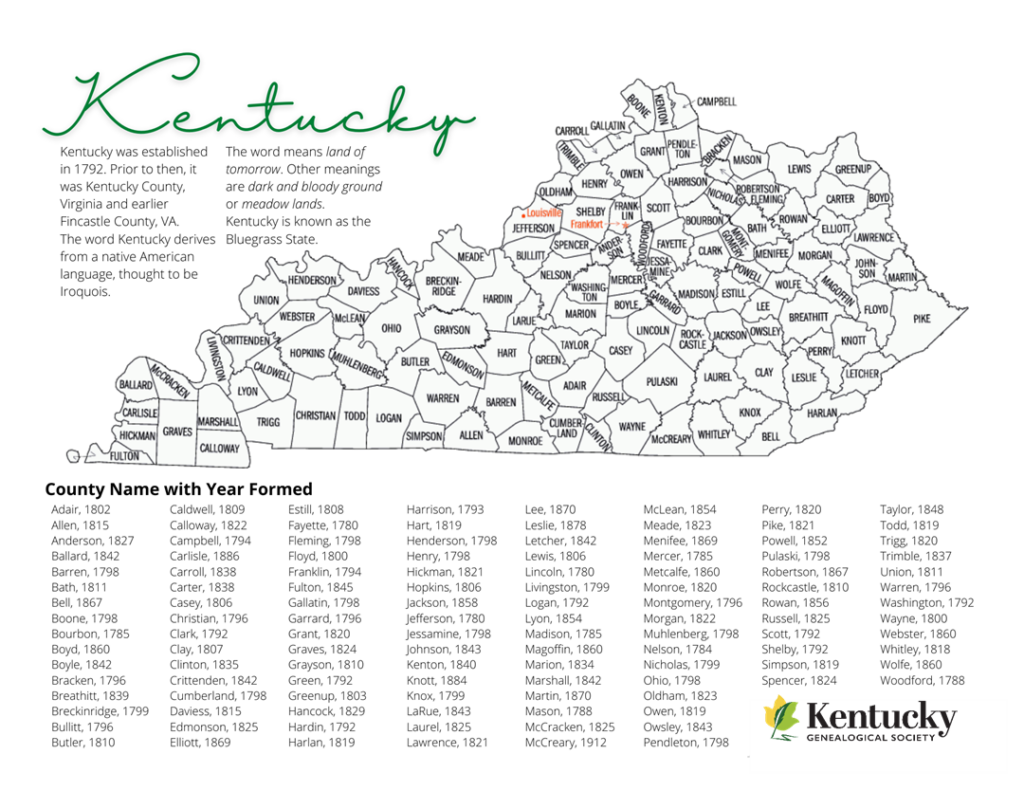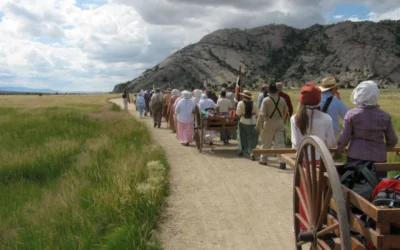Recently on our Facebook page we asked “What is your best genealogy tip for someone new to family research in Kentucky?” We were not disappointed, over 100 folks responded with some fantastic tips. All those who responded had good and even funny advice.
We categorized and condensed the tips and suggestions in the following post. If you are new to researching in Kentucky or even have been at it for several years, there’s a tidbit you can use.
Research Must: You Need a Game Plan
All researchers need a game plan to keep them on track. Many suggested as a first step you become familiar with the many sources available. Pay attention to those not online as well, such as archives, historical societies, public libraries, and museums.
There are sources that may get overlooked. In response to one researcher looking for a family member, Amy Dunn suggested she contact the local funeral homes to see what records they may have.
Keep in mind that not all Kentucky records are actually in Kentucky. Surrounding states, such as Virginia, Ohio, and even Florida, might have land grant information, wills, photos, and other valuable documents.
If you are a true beginner, here is our six-step getting started guide that includes free genealogy forms.
Researching in Kentucky Counties
Another key piece of advice for a new researcher is to determine where in the state you need to research. Kentucky has many counties where vital records are stored. Once you determine a county, your work is not over.
“Keep an open mind. Remember Kentucky was once part of Virginia. In the keeping an open mind department, I have found that a lot of my family stories were proven wrong, so keep an open mind and don’t get offended.” said Pati Sears-Burnett.
Sharon Tabor suggested, “Keep a map and dates of county formation. Ancestors may be recorded in multiple counties without ever moving.”

Map of Kentucky with the date the county formed. Source: KYGS Collection
“There are 120 counties created over time. To search records you need to know when they were formed and from what parent county,” continued Tabor.
Many noted how helpful it was to use the local county resources of where the family lived. “I started with the historical society in [their] hometown. I found a wealth of documented info that certainly lit up the correct paths! Document every fact you find, even if it’s a word of mouth fact,” offered Ellen West Radford.
Build Connections with Other Researchers
Many folks commented on how important it was to build a network. The network must contain other family researchers who you meet through societies. You want people researching the same family or at least the same area.
Margaret Danko said, “Join the Kentucky Genealogical Society especially if you are from another state.” We believe this was among the best suggestions made, but we may be biased.
Facebook and other social media sites are another place to build a network. There are several groups for Kentucky research on Facebook, some at the county level.
“Join county specific Facebook [groups] and ask questions. I guarantee someone knows your people!” commented Kamia Runyan Jackson.
Less thought of places to make friends is the Kentucky Vital Statistics office and the local county clerk’s office. There are many places in the counties to make friends, such as the public library or local historical society.
Working with Sources
Be conscientious with your research. If months pass between the time you collect and use the information, you may forget where or how you got the information.
“Document your sources! It will be important in the future when comparing two conflicting bits of information. Such as a birth certificate versus Aunt Molly’s recollection of her second cousin’s birth 50 years before,” suggested Chris Forest.
By the way, there are many webinars in our archive that explain how to document sources properly.
Many researchers noted how many sources were not online, but in the field.
“Go to the source, visit where your people lived. There are more records than just online!” said Susan Hudgens.
This thought was continued by Eilen Cox, who said, “Go to the Kentucky Archives, visit the Kentucky State Library, and the local genealogical or historical society libraries. Visit the actual court houses (including surrounding county courthouses).”
Research Sources: Family Lore
Carefully evaluate family lore. While not all stories are false, some stories may get taller over time. Your family members just repeat the stories they were told.
Marti Taylor suggested, “Talk to your oldest relatives and maybe record them. They may not be factual but don’t dismiss them.”
“Not everyone is related to the Cherokee (or other indigenous people) no matter what stories grandma Sally passed along. This is the most repetitive fallacy ever,” reminded Monica Daugherty.
These stories are fun and often entertaining, so what should you do?
“Don’t take ‘family stories’ as gospel but do take down those names and dates wherever possible. Then go to the counties’ historical society or state archives to verify the information. Don’t be shy about asking for help to find your sources. You WILL find things – often not what you were expecting!” said Kelly Knight.
Sometimes these stories are true or have a grain of truth to them.
Research Sources: Cemeteries
A cemetery can be the key to understanding an ancestor and their connection in your tree. Lisa Wyman had this advice based on recent experience.
“If you want to visit cemeteries don’t necessarily trust local info online. Maybe call a local PVA or courthouse to make sure it’s where online info says it is. Many [cemeteries] are on private property and although there’s supposed to be public access you need to get in contact with the owner first.
I went to find a church cemetery yesterday and the Find A Grave local info was wrong. It said it was at a church but it wasn’t at the new XYZ Church, it was down the road where the old original (same named) church was and the graves are now in some woods at the back of a gated field. The only reason I knew that is because I asked a random person.”
A follow-up comment from Amy Dunn suggested the Kentucky Heritage site since there may not be a convenient or knowledgeable person available.
Also, Chris Padgett provided a great webinar about Kentucky cemeteries, that is available in our Learning Library.
Research Sources: Federal Records
It is true that the census records are official documents for the US government, but it doesn’t mean they are accurate. The census takers may not have received an A for penmanship or accuracy.
“Recognize that census takers as late as 1990 were told ‘If you cannot find them ask a neighbor or just guess.’ In short, do not put too much stock in what is written in the census either way,“ said Janie Biggs.
Chris Anderson had an example. “My Aunt Cleo was an infant in the 1900 census and was listed as a son!”
Debbie Nelson noted, “Don’t believe everything you read on a census!! [Census takers] got relationships incorrect many times. They wrote what they thought made sense even if it wasn’t the facts. My mother lived with her grandparents and is listed as daughter, instead of granddaughter.”
Don’t forget to check the court papers, tax lists, and land records for the county. Just remember, these records may suffer from the same penmanship issues.
Final Words of Advice
Most of us will encounter a brick wall or not find the records we need. John W. Haertling jested, “On those really difficult research days, don’t forget the bourbon!” Yes, perhaps a solution we share with our ancestors.




